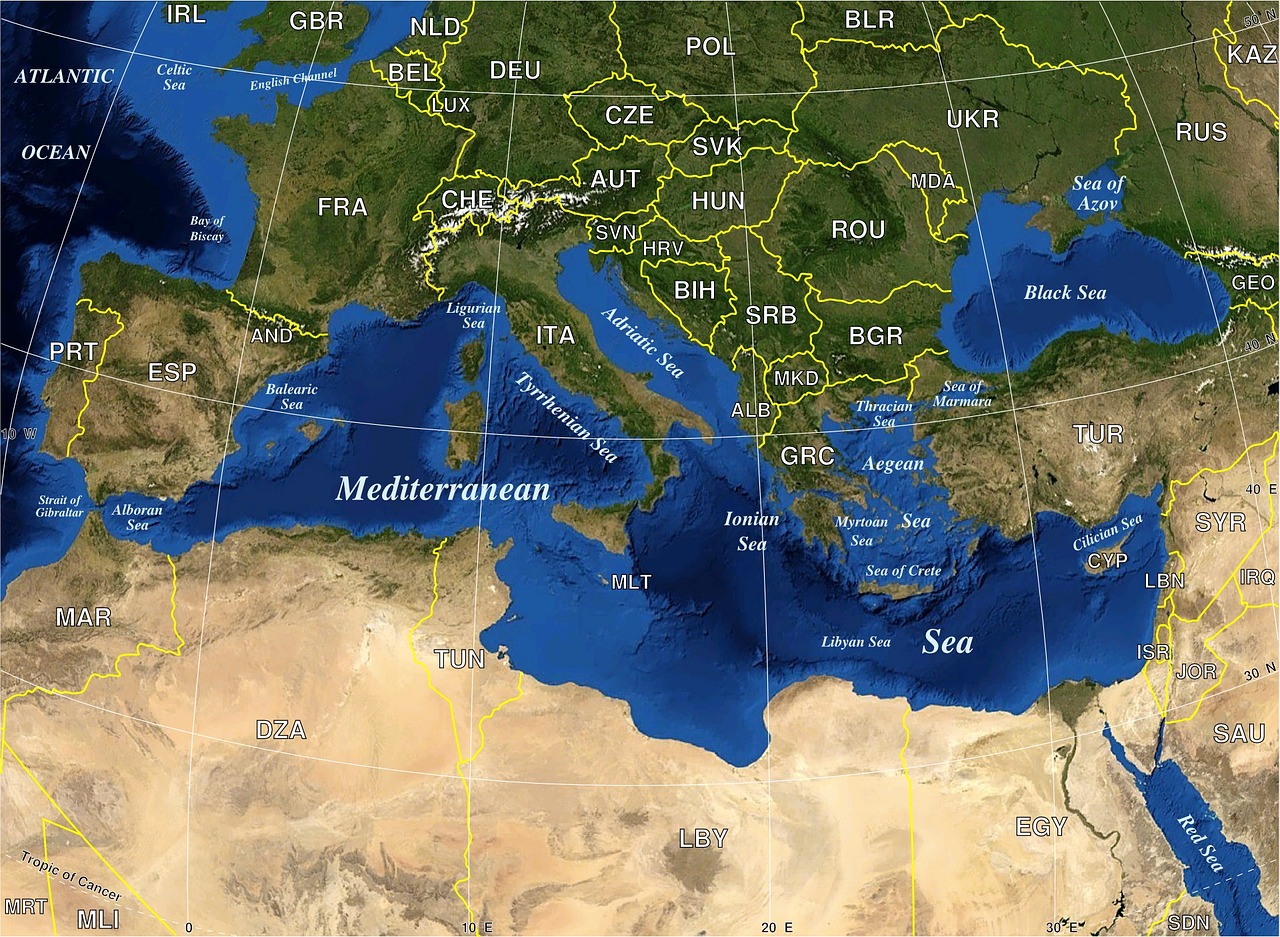In this article, Annalisa Perteghella reflects on the need of a new Mediterranean strategy, and the risks of instability and insecurity arising from climate change in the wider region. Scientists define the region as a climate change hot spot, hence adaptation actions can no longer be postponed. The risk of drought, the rise in sea level, political instability, different economic systems and the dependence of some countries on oil and gas revenues increase the level of vulnerability. In this context, Italy must quickly equip itself with a climate security strategy capable of monitoring developments, defining foreign policy priorities and developing policies for preventing and responding the impact of climate change.
The link between security and climate change is increasingly recognised. According to the IPCC’s report Climate Change 2022: Impacts, Adaptation and Vulnerability, current levels of global warming threaten lives, property, critical infrastructure, energy and transport systems. Warming above 1.5°C would make it even more complex and costly to ensure human security, with impacts on political and economic systems, stability and international security. The 2023 World Economic Forum’s Global Risks Report, which collects perceptions of global security risks – through a sample of more than 1,200 experts – lists climate change as the risk with the greatest impacts over the next ten years. In particular, failure in mitigation ranks first, adaptation second, and natural disasters and extreme events third.
The broader Mediterranean region – which includes Middle East and North Africa, as well as the Gulf area – is strongly exposed to the risks of instability and insecurity arising from climate change. Italy, as well as the other southern European countries facing the Mediterranean basin, is strongly exposed both to direct impacts, which are manifesting themselves in the region with increasing intensity and frequency, and to the consequences of these impacts in the countries on the Southern shore.
Data from science
Indeed, scientists state that, due to cumulative emissions, the average global temperature will continue to rise until 2040-2050. Mitigation actions implemented today will therefore influence climate change trajectories from 2050 onwards, according to different scenarios identified by the IPCC. In the ‘best-case’ scenario (RCP2.6), emissions will peak in 2020; in the intermediate case (RCP4.5) in 2050, and then decline rapidly. In the worst-case scenario, emissions will continue to rise (RCP8.5). If it is urgent to act now with mitigation actions in line with the RCP2.6 scenario, it is equally urgent to put in place actions to adapt to the impacts of climate change that are bound to increase in the coming years due to rising temperatures and the destruction of ecosystems.
The aggravation of extreme weather phenomena in Mediterranean
Throughout the region, we will see increasingly hotter and more extended summer periods. While rainfall will decrease in much of the region, intense rainfall events will become more intense and occur more often, causing more frequent and more destructive flooding. Other extreme weather events (storms, including sandstorms, cyclones, etc.) will intensify. By 2050, sea levels could rise by between 0.2 and 0.25 metres in Tangier, Tunis, Alexandria and Muscat, with serious consequences for residents, infrastructure and tourism in coastal areas.
Availability of water resources
Climate change will also affect the availability of water resources. The wider Mediterranean region already has some of the highest levels of aridity in the world. This situation is due to both the climatic conformation of the region and the inefficient use of water resources. For many years, the region has been using more water than it recovers naturally, for example by drawing excessively from aquifers or resorting to desalination. According to the baseline water stress ranking published by the World Resources Institute, which is based on the ratio of total water withdrawals to available renewable water reserves, all 19 MENA countries suffer from ‘extremely high’ (12) or ‘high’ (7) water stress. By 2040, with projected population growth, the majority of the region will be under extreme water stress. This will have serious consequences for the agricultural sector, which, including fisheries and forests, employs 11% of the labour force and contributes in part to food security and inter-regional trade.
Food security
Some Mediterranean countries, including those in North Africa, are also highly vulnerable to the impacts of climate change elsewhere, mainly due to their heavy dependence on food imports, particularly wheat. Export restrictions by supplier countries and/or price rises due to increasingly frequent droughts therefore risk seriously jeopardising food security in the region, with possible repercussions in terms of social and political stability.
Different levels of vulnerability in the Mediterranean
While climate change-related phenomena will manifest themselves more strongly in some parts of the broader Mediterranean region than others, the extent of impacts will depend on the level of vulnerability of the people, economies and political systems affected. Vulnerability assessment takes into account potential impact, which results from the level of exposure and sensitivity to climate risk, and adaptive capacity. Thus, if the potential impact is high but adaptive capacity can match it, vulnerability could be low to medium, while a lower potential impact could result in higher vulnerability if adaptive capacity is low.
Sensitivity to climate risk and other shocks is not evenly distributed across the region. Countries that depend heavily on agriculture will be more sensitive to drought risk. Phenomena such as sea-level rise will be strongly felt in exposed geographical areas with a high density of urban development, for example the Egyptian coast, Gaza, Morocco and the Gulf coasts. Adaptive capacity, i.e. the ability of governments in the region to cope with the challenges posed by climate change, also varies from country to country. Access to finance, dissemination of technology and the preparedness of local and national institutions will make a difference in terms of human and economic losses. For example, despite being in the path of tropical storms, Oman currently shows less vulnerability to climate change than neighbouring Yemen, given the latter’s state of conflict, fragmented governance and crumbling infrastructure.
Political stability and climate
Political instability and conflict situations increases the level of vulnerability: partly because in such situations the attention of governments is diverted from the long-term planning that is needed to build resilience to impacts; partly because political instability discourages the investment and funding needed to build resilience. Situations of conflict or rivalry between states also negatively affect the ability to respond to impacts, for which cross-border cooperation would instead be necessary. One example is Iran and the Gulf Cooperation Council states, which share the waters of the Persian Gulf, the Strait of Hormuz and the Gulf of Oman. Cooperation between these countries would be essential to restore the Gulf’s fragile coastal ecosystems, but political conflict, mutual distrust and securitisation of environmental issues (especially in Iran) make such cooperation extremely difficult.
Economy and climate
The different conformation of the region’s economic systems also contributes to different levels of vulnerability. With the exception of Israel, the economies of North Africa, Middle East and Gulf countries remain dominated by the state and/or business elites linked to the political system. Theoretically, a strong role for the state can be beneficial in building capacity to respond to the impacts of climate change through the mobilisation of large-scale capacities, the preparation of specific plans for the agricultural sector, and the involvement of state-owned companies with technical expertise that can be deployed in the event of a crisis. However, in practice, this model – combined with a system of subsidies on goods such as energy and water – has caused widespread inefficiency and ended up repressing entrepreneurship and private initiative. The case of Lebanon shows how an apparently privatised economic space can still be dominated by cartels linked to political elites, resulting in a system that is equally inefficient in building resilience.
The role of oil & gas in the Mediterranean
The dependence of some of the region’s economies on oil and gas revenues is a further element of vulnerability. The transition to a globally decarbonised energy system will lead to a contraction of fossil fuel markets. The International Energy Agency’s Net Zero to 2050 scenario, in line with the IPCC’s 1.5°C scenarios, demonstrates the drastic reduction in demand for coal, oil and gas needed to meet the Paris Agreement targets. This poses a challenge for economies in the region that depend on oil and gas exports, such as Algeria, Libya, Iraq and the Gulf countries. In these countries, building resilience inevitably involves diversifying economies, new domestic energy and fiscal policies, opening up to the private sector, and developing the necessary skills. The Gulf countries, having already embarked on economic diversification processes and being able to count on large funds of sovereign wealth, are less vulnerable to shocks in hydrocarbon prices and demand than countries like Algeria. However, as the oil price crisis caused by the Covid-19 pandemic has shown, accelerating the energy and economic transition is increasingly urgent.
The consequences of inaction
Failure to develop capacities to adapt and respond to the impacts of climate change risks aggravating the already precarious security situation in the region, exposing Italy and Europe to new threats.
Against a backdrop of increasing water scarcity, high food prices and a growing population, there is an increased risk of conflicts over resources, migration from rural to urban areas, the inability of governments to maintain a subsidy system on goods such as food and energy, as well as the inability to purchase food on global markets, especially in the face of rising prices due to global climate shocks and lower economic revenues from the falling demand for hydrocarbons needed to meet the Paris climate targets.
The rise of instability depends on the extent to which mistrust and frustration with governments already exists, as well as on the ability of governments to prepare for and respond effectively to shocks. What also matters is how governments in the region respond to expressions of dissent related to or triggered by climate impacts: repression is more likely to lead to instability (at least in the medium to long term) than openness measures such as engaging in dialogue. An extreme weather event mishandled by the authorities, for example, could combine with factors such as unemployment, high food prices and the absence of freedom of expression, leading to mass protests.
Climate and migration
A further consequence could be increased migration pressure. Irrespective of the impact of climate change, countries in the region will face high levels of population growth. This will result in increased pressure on the state’s ability to provide services such as water and energy, and, based on current food consumption trends, increased demand for imports. There is likely to be increasing migration, especially within national borders from rural to urban areas. But the Mediterranean region, particularly North Africa, is also a transit region for migration routes from sub-Saharan Africa, which is likely to be increasingly impacted by both climate change and the different open conflicts on the continent. However, with almost half of the region’s inhabitants under the age of 25, the demography also represents a huge potential for growth and innovation, compared to Europe’s ageing population.
Conclusion: why Italy needs a new Mediterranean strategy
In face of this scenario, there is an urgent need for Italy to integrate the climate security dimension into its foreign policy, engaging in interventions to support resilience building in the countries of the extended Mediterranean region, both bilaterally and at the European level, for example through participation in Team Europe initiatives. The cooperation and development strategies of the Italian Ministry of Energy Security (MASE), the Ministry of Foreign Affairs (MAECI), and the Italian Agency for International Cooperation (AICS), as well as the resources of the recently established Italian Climate Fund, need to be designed and earmarked for adaptation and resilience-building interventions, especially for the region’s water and food systems, and to address loss and damage.
At the political level, on the other hand, it is necessary for Italy to equip itself with a climate security strategy that – starting from the scientific data made available for example by the Euro-Mediterranean Centre for Climate Change (CMCC), the Italian Institute for Environmental Protection and Research (ISPRA) and European satellite observation programmes such as Copernicus -, monitors developments, defines foreign policy priorities and elaborates policies for preventing and responding to impacts. At the same time, it is necessary to support countries in the region in their efforts to build a fiscal and legal framework capable of attracting international funding and investments. The region still lacks market-based instruments for private sector involvement in building resilience to climate risks. Although green debt issuance (sukuk and traditional bonds) in the region has increased rapidly since 2015, this still represents a small fraction of the global total. A number of instruments, including the use of green bonds and de-risking mechanisms, can be employed to encourage the private sector to invest in areas such as green building, smart agriculture, thermal insulation and water conservation. To optimise the effectiveness of these instruments, it is important that the interventions are accompanied by fiscal and legal improvements aimed at creating greater transparency.
In the current international context, marked by multiple crises, it is necessary for Italy to create partnerships with the countries of the extended Mediterranean region aimed at building a governance system resilient to shocks and supporting the transformation of economic systems in favour of decarbonisation and climate resilience, which contribute to the diversification and security of the economy. New energy partnerships with countries such as Algeria and Egypt, aimed at providing a response to the energy crisis by only incentivising new gas production and exports, are not an adequate response to either the needs of energy transition or securing against the impacts of climate change. On the contrary, mitigation and adaptation must be placed at the heart of any new partnership, along with support for building sustainable food and water systems and diversifying economies. What is needed is therefore the ability to link short-term responses to long-term ones, laying the foundations for the construction of a new model of cooperation, and a new role, for Italy in the Mediterranean.






